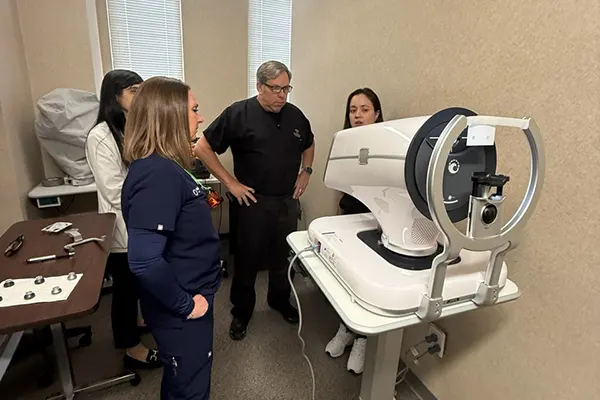Conditions of the Cornea
Conditions of the Cornea
Steven Silverstein MD, FACS is a fellowship trained cornea specialist. He is an internationally renowned expert, often engaged to consult with medical companies and educate physicians around the world regarding cornea afflictions and treatment.
A healthy cornea is critical to your vision and general health. When your cornea is damaged by injury, infection or disease, your ability to focus is compromised because the incoming light can be distorted or blocked. Some corneal issues cause pain, others are only detected by your physician during a comprehensive eye exam.
Symptoms of corneal issues include:
- Blurred or reduced vision
- Pain in the eye
- Stinging or burning in the eye
- Sensitivity to light
- Redness or inflammation in the eye
- Swollen eyelids
- Sensation of a foreign object in the eye
- Increased tear production
- Headache, nausea, fatigue
If you experience any of these symptoms, seek help from an eye care professional.
Prokera®
PROKERA is offered to our patients with a poorly healing cornea from trauma, infection, and inflammation. PROKERA is a special type of contact lens made of amniotic tissue. It’s a biologic corneal bandage which has natural therapeutic actions known to heal the eye faster with less pain, scarring and inflammation, and it’s applied with a simple procedure and is easily inserted and removed in our office. Once removed, the cornea is rejuvenated so you can see and feel better.
PROKERA is similar to a contact lens and is made of amniotic tissue, which is known for its natural therapeutic actions. The amniotic tissue used in PROKERA is provided by a tissue bank regulated by the FDA and has passed numerous quality control tests making it safe and effective. It is the only U.S. Food and Drug Administration (FDA)-cleared therapeutic device that reduces inflammation and promotes healing. For more information visit www.prokerainfo.com.
Cornea Transplant Surgery
If your cornea is badly damaged, you may be a candidate for a transplant. Cornea transplant surgery, also known as corneal grafting, involves replacing a damaged or diseased cornea with donated corneal tissue, either partially or entirely. The majority of cornea transplants result in significant improvement in visual function for many years or a lifetime.
Oculoplastic Surgery
Oculoplastic surgery is performed to treat abnormalities of the eyelid and face, the lacrimal (tear duct) system and the orbit in patients of all ages whose vision or lifestyle are affected. Cosmetic options such as Botox® and Latisse® are also available.
Common Corneal Afflictions
CORNEAL ABRASIONS: Caused by trauma to the eye, abrasions tend to be quite painful, and put the cornea at risk for infection (corneal ulcer). This condition must be treated immediately.
CORNEAL DYSTROPHY: Often a genetic, sometimes progressive disorder in which abnormal material accumulates in the cornea. Some dystrophies are asymptomatic; while other cases may require medication, laser therapy or corneal transplantation.
CORNEAL ULCER: A severe infection, often common in contact lens wearers. Most corneal ulcers can be treated with topical antibiotics, but corneal ulcers sometimes cause permanent scarring requiring corneal transplantation.
KERATOCONUS: A gradual thinning of the cornea’s round dome structure, causing a cone-like protrusion and blurred vision. Special contact lenses may fix the issue, but a corneal transplant may be required in severe cases.
KERATITIS is an inflammation of the cornea. Noninfectious keratitis can be caused by a minor injury, or from wearing contact lenses too long. Infection is the most common cause of keratitis. Infectious keratitis can be caused by bacteria, viruses, fungi or parasites. Often, these infections are also related to contact lens wear, especially improper cleaning of contact lenses or overuse of old contact lenses which should be discarded. Minor corneal infections are usually treated with antibacterial eye drops while severe infections may require more intensive antibiotic or anti-fungal treatment to eliminate the infection, as well as steroid eye drops to reduce inflammation.
PTERYGIUM: A noncancerous growth usually found on the inner or outer corners of the eye. When a pterygium becomes red and irritated, eye drops or ointments may be used to help reduce the inflammation. If large enough to threaten your vision, it can be removed surgically.
ALLERGIES typically affect the eye. Symptoms in the eye include redness, itching, tearing, burning, stinging, and watery discharge. Antihistamine decongestant eye drops effectively reduce these symptoms. We perform full, comfortable allergy testing at Silverstein Eye Centers, which can help guide us to the most effective treatment for you.


